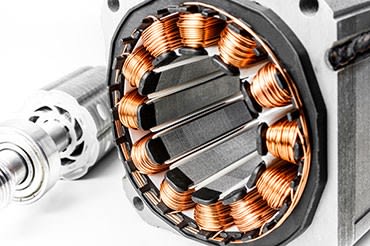Why are brushless motors perfectly suited to ecodesign?
Follow articleHow do you feel about this article? Help us to provide better content for you.
Thank you! Your feedback has been received.
There was a problem submitting your feedback, please try again later.
What do you think of this article?
Although they require a more complex electronic drive tool than conventional brushed motors, V dc brushless motors are increasingly seen in numerous applications, from portable electric tools to automated systems, including electric bikes and even drones.
Brushless motors perfectly meet the increasingly stringent requirements of machine designers in terms of reliability, service life, energy efficiency, weight and noise levels.
- Increased service life and reliability.
Brushless motors can achieve a service life of 20 000 hours, which is a value almost equivalent to V ac brushed motors and 4 times greater than V dc brushed motors. This is mainly due to the lack of mechanical contact between the rotor and the stator. This characteristic gives rise to a significant drop in heating rates and interference, which contribute to mechanical wear.
- Reduced weight
The structure of brushless motors means they are more compact and can be 2 to 3 times lighter than a V dc brushed motor.
- Higher energy efficiency
The performance of brushless motors is considerably higher than that of brushed motors, in particular due to electronic management of the motor control. The lack of friction and voltage drop at the collector also improve efficiency.
- Quieter
The brushless motor structure generates less noise and fewer vibrations. The electronic commutation means the speed can be adapted to obtain the quietest operating point.
- Speed variation and interlocking
The electronic circuitry controlling brushless motors allows precise speed control which takes into account information on the state of the motor supplied by the sensors. This self-adjustment of the speed is called speed interlocking.
- Other benefits: high starting torque, limited interference, reduced heating, higher protection rating and less inertia.
Sometimes called electronically commutated motors (ECM), brushless motors comprise a stator fitted with three coil clusters and a rotor fitted with permanent magnets. The coils must be powered successively to create a rotating magnetic field that attracts the magnets and thus aligns the rotor with the magnetic field.
Excitation of the coils is managed by a specific circuit called the brushless motor controller. This circuit switches the current from the stator coils in synchronisation with the position of the rotor supplied by the sensors or with the aid of a calculation based on the back electromotive force. The controller can also precisely measure out the current required by the motor so that it operates within its optimum performance range.
All these technical specifications are therefore perfectly suited to the design of products with optimised energy efficiency.
For more on Brushless Motors head over to RS


